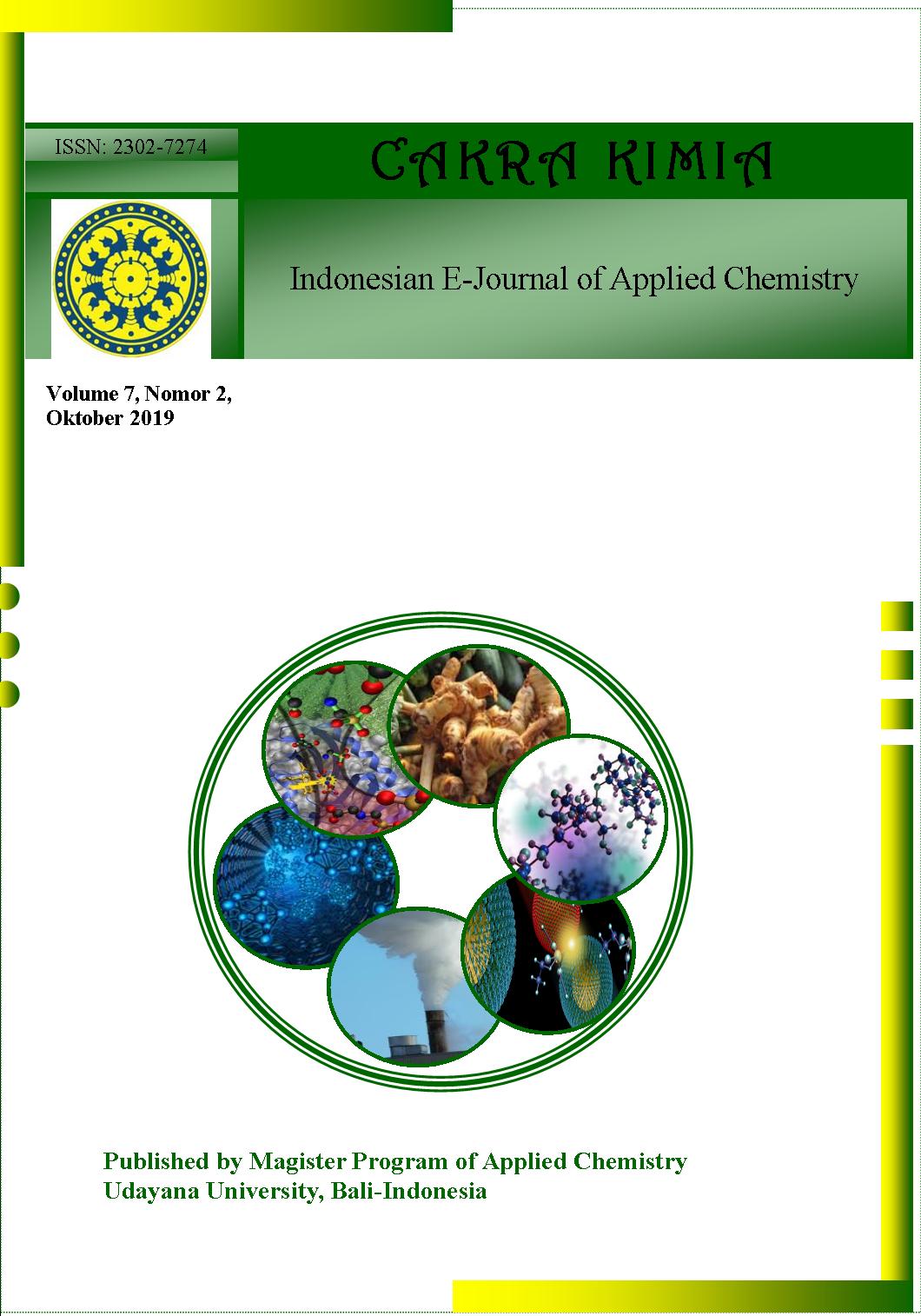FITOREMEDIASI DENGAN TANAMAN PACING (Speciosus Cheilocostus) UNTUK MENURUNKAN KANDUNGAN Cr LIMBAH CAIR LABORATORIUM
Abstract
ABSTRAK: UPT. Laboratorium Analitik Universitas Udayana merupakan laboratorium pendidikan yang berfungsi menunjang kegiatan Tri Dharma Perguruan Tinggi. Adapun kegiatan yang dilakukan adalah penelitian, praktikum dan analisis kimia bahan sehingga menghasilkan limbah cair yang mengandung bahan-bahan kimia berbahaya. Sistem pengolahan air limbah yaitu fitoremediasi, menggunakan tanaman Pacing (Cheilocostus speciosus) telah dicoba untuk mengolah limbah cair laboratorium. Konstruksi unit pengolahan terdiri dari sebuah bak terbuat dari beton dengan media tanah berukuran 7 m x 1,2 m x 0,34 m yang ditumbuhi Pacing. Penelitian dilakukan selama dua minggu meliputi penelitian eksperimental, observasi pre dan post perlakuan. Efektivitas sistem fitoremediasi dalam menurunkan kandungan Cr adalah 65,02 % pada hari keempat, Kandungan Cr berkurang setelah fitoremediasi.
Kata kunci: Fitoremediasi, efektivitas, Pacing Cheilocostus speciosus)
ABSTRACT: UPT Analytical Laboratory of Udayana University is an educational laboratory that functions to support the activities of the Tri Dharma Perguruan Tinggi. The activities carried out are research, laboratory practice and chemical analysis. The activities produced liquid waste containing dangerous chemicals. Treatment system of the liquid waste using Phytoremediation of pacing plant ( Cheilocostus speciosus) has been studied to reduce the concentrations of heavy metals of laboratory liquid waste. The construction of the processing unit consisted of conerete tank filled with soil media grown over with pacing plant. The size of the tank was 7 meters in length, 1.2 meters in width and 0.35 meters in depth. The duration of the experiment was 2 weeks, by observation of pre and post treatment to record the effectiveness of the pacing plants in reucing the concentrations of Cr in liquid waste. The results showed the effectiveness of the system in reducing the concentration of Cr is 65,02 % on the fourth day waste water treatment system.The concentration of Cr decreased significantly after treatment.
Downloads
References
[2] Suryati, T. dan Priyanto, B.2003. Eliminasi logam Berat Kadmium Dalam Air Limbah Menggunakan Tanaman Air. Jurnal Teknik Lingkungan P3TL-BPPT.4(3)
[3] Suyasa, I W.B., Suprihatin, I.E.,dan Sugianthi, I.G.Kd. R., 2012 Pengolahan Air Limbah Pembangkit Listrik PT. Indonesia Power dengan Metoda Flotasi dan Biofiltrasi Saringan Pasir Tanaman. Jurnal Kimia, 6 (1):
[4] Sandika, I M.G.Sudyadnyana., Suyasa, I W.B. dan Suprihatin, I.E., 2012. Pengolahan Limbah Pencucian Rumput Laut untuk Menurunkan BOD dengan Sistem Biofiltrasi Ekosistem (SBE). Jurnal Kimia, 6 (2):
[5] Suprihatin, I.E., Suyasa, I W.B.,dan Laksmiwati, A.A.I.A.M., 2015. Penurunan Kandungan Ammonia Limbah Cair Rumah Sakit Dengan Trikling Filter dan Lahan Basah. Prosiding Seminar Nasional Sains dan Teknologi. 2015. Denpasar. 20-30 Oktober 2015
[6] Priyatno, B. dan Prayitno, J. 2012. Fitoremediasi sebagai Sebuah Teknologi Pemulihan Pencemaran, Khususnya Logam Berat (online) Available at : http:// ltl. bppt. tripod.com/ sublab/ flora1.htm. Diakses tanggal 9 Juni 2015.
[7] Dzantor, E. K.,(2007). Phytoreme-diation: the state of rhizosphere engineering for accelerated rhizo-degradation of xenobiotic contami-nants., Journal of Chemical Tech¬no¬-logy and Biotechnology.
[8] Arikunto, S.2006. Prosedur Peneli-tian suatu Pendekatan Praktis. Edisi Revisi VI Rineka Cipta. Jakarta



 Petunjuk Penulisan
Petunjuk Penulisan
